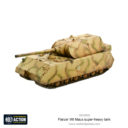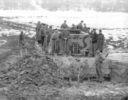Bolt Action: Panzer VIII Maus
Warlord Games haben ein neues Modell für Bolt Action und Konflikt 47 angekündigt.
This Friday Warlord release a model of one of the most enigmatic armoured fighting vehicles of the Second World War. The subject has the fairly innocuous designation VK100.01 Porsche Type 205 yet to any serious student of WW2 AFVs this subject is better known as the Panzerkampfwagen VIII Maus (Mouse).
This example of late war German imagination may be named after a tiny rodent but it is anything but mouse like. Weighing an astonishing 188 metric tons the Maus still holds the record as the heaviest fully enclosed armoured fighting vehicle ever built. Unlike the majority of the so-called ‘paper panzers’, advanced German tank designs which only existed in technical schematics and project documentation, the Maus was actually built with two prototypes almost complete and perhaps as many as 9 others under construction when Hitler cancelled the programme in late 1943.
There are even unsubstantiated rumours that one of these prototype vehicles may have been used in combat against the Soviets. Speculations on how the Maus would have actually performed in combat are of course securely in the realms of ‘what-if’. However, one of the great things about Bolt Action and wargaming in general is you can experiment with these remarkable examples of the ‘what might have been’ and incorporate them into your gaming.
I can imagine that there are plenty of ‘tread heads’ out there in the general Bolt Action Community who will find the temptation of adding one of these monsters to their late war German army difficult to resist.
With the recent release of Konflikt ’47 there is also no reason why the Maus cannot be incorporated into German Army lists for that game also.
Prototype V2 ready to head to the front
A Bit of History
The shock of first contact with advanced Soviet T-34s and KV-1s during Operation Barbarossa had been a major wake-up call to the German Panzer forces whose Panzer III and IV designs had proven capable of handling anything the Western Allies could currently put into the field. This was especially true when they were a part of well led German tank formations. While it was true that by 1943 new and impressive designs such as the Panther and the Tiger were being made available to the Panzer divisions. The German leadership influenced heavily by Adolf Hitler wanted more.
V2 on the move, note the camo scheme.
The new tanks were bigger and heavier than their predecessors clad in thicker armour and carrying larger and more effective anti-tank guns and Hitler with his fascination for war winning ‘Wunderwaffe’ was always looking for the next big step and that meant bigger tanks with larger guns. Whether this fascination for a larger tank was influenced by Hitler’s experience as an infantryman in the First World War trenches cannot be said, but there was certainly no shortage of powerful and influential leaders in the German armaments industry that wanted to fuel the Fuhrer’s obsession.
Prototype V2 – what might have happened if the allies had to confront it?
Chief amongst these was Ferdinand Porsche, a Czech born engineer, who in 1931 created the Auto UnionAG company which would design and build the Volkswagen Beetle or ‘people’s car’. A strong supporter of the Nazi party he was accepted for German citizenship in 1934 and took on the persona of the ‘Great German Engineer’. He was a great friend of the SS and by 1943 held the paramilitary rank of SS-Oberfuhrer.
Prototype V1 with mock turret – testing on frozen ground.
In 1941 he submitted a design to be considered in the heavy tank competition that would eventually result in the Tiger I. Although 90 chassis and a few completed examples of the Tiger(P) were produced they were overly complex with their hybrid electric power plants, and further production was cancelled as the rival Henschel design was adopted. The majority of the unused chassis were converted into the Panzerjager Tiger (P) which at one time bore the nickname ‘Ferdinand’ after their creator.
A field change of V1’s tracks track links
Smarting with the embarrassment of the Tiger (P) the designer played to Hitler’s obsessions by presenting the VK100 Porsche Type 205. A design for a super heavy tank far bigger than anything previously considered. Hitler enthusiastically approved it and demanded that a prototype be produced and demonstrated as soon as possible. Originally the design was to be called Mammut or Mammoth, but demonstrating perhaps a little humour and irony, it was renamed Mäuschen or (Little Mouse). When the prototype was produced the name Maus (Mouse) stuck.
A certain amount of bravery required! – Note the camo scheme on V1
The Maus was a huge ‘breakthrough tank’ designed to penetrate heavy enemy defences whilst shrugging off all the enemy could throw at it. To do this it needed to large and very well protected.
Weighing in at over 180 tons and carrying armour of up to 250mm which at the time was proof against most current anti-tank guns it appeared to promise much.
V2 destroyed by crew using explosives in the engine compartment – or did it see combat?
Its main armament was prodigious comprising of not one but two main guns. The primary gun was a 128mm KwK44 L/55, a highly effective weapon that also saw much use in the Jagdtiger Tank destroyer. At various points during its development both 150mm and 170mm main guns were considered however Hitler, wishing to see his ‘toy’ deployed as soon as possible, settled on the 128mm.
Where most tanks had a co-axial machine gun fitted alongside the main gun the Maus took this concept to the extreme by having the co-axial mount fitted with a 75mm KwK44 L/36.5 gun. This was no less than a shortened version of the 75mm carried as main armament by the later Panzer IV variants! Whilst this might be seen as a little over the top there were some good points to this arrangement. As a breakthrough tank the Maus would face multiple anti-tank and other fortified positions which would need to be neutralised. Whilst the main 128mm could handle these, only around 30 rounds of ammunition would be carried, many of which would be penetrator anti-tank rounds. The 75mm on the other hand was quite capable of handling these sorts of targets and of the 200 rounds carried the majority would be high explosive.
The soviets using captured equipment remove the turret from V2
Despite recognising that the Maus would be operating in a highly hostile environment the initial prototypes also suffered from a dangerous Porsche trademark of having little or no close in weaponry to handle infantry assaults. This problem had disastrously impacted the ‘Ferdinand’ tank Destroyers deployed at Kursk. Only after fierce objections from the then Inspector of Tanks Heinz Guderian were additional defensive machine guns added to the Maus design.
The initial plan was for a prototype to be tested and evaluated by June 1943 and a production line to be set up to produce 150 vehicles. However, like many advanced technology projects the Maus was subject to constant review and revision and finally cancelled in October 1943 but not before 2 prototypes V1 and V2 had been built. Despite cancellation both vehicles were continually tested and their performances evaluated. The testing showed that a production Maus would have faced many problems.
Prototype V1 – now in Russian hands about to have its false turret removed
Like the Tiger (P) the Maus would have mounted a traditional internal combustion engine acting as a generator providing power to two electric motors which would drive the tracks. It soon became clear that the electric drive whilst highly advanced would deliver a poor performance due to the sheer size and weight of the vehicle itself. Initial prototype trials also showed that cross country speed would only be around 8 miles per hour (13 Kph).
It was also became clear that the Maus was far too heavy for the majority of road bridges making river crossings problematic. As this would be a major tactical failing an ingenious but complex solution was developed. Any Maus crossing a river would operate in ‘Buddy Pairs’. Equipped with a schnorkal to provide breathing air for the six-man crew the Maus could be submerged to a depth of 8 metres. Electrical power for the track drives would be provided by the second Maus which would be high and dry on the river bank running its diesel or gasoline engines at full capacity to generate the required power.
Possibly a picture of V2 Turret and V1 Hull (note the different camo) combined on their way to Russia
Though bold in concept the thought of a tank operating like a submarine connected by a flimsy cable to its only power source must have been daunting to any prospective crew. The V2 prototype fitted with a production turret and armament was actually delivered in March 1944 and was tested at the Kummersdorf tank testing range along with the turretless V1.
On display at Kubinka with a new paint job (note the holes in the frontal armour from post war target practice)
However, the story of the Maus does not end there. Whilst various accounts insist they were deliberately blown up to avoid capture others have speculated that as the final curtain descended on the Third Reich the prototypes were used in either a last ditch defence of Kummersdorf, or dispatched to help in the defence of the OKH HQ at Wünsdorf. As there are no mentions of any encounters in Red Army records these stories should be taken with a pinch of salt, but the possibility has fuelled many rumours. One Maus (made up of parts from 2 that were captured) did actually survive the war ending up in the Russian Armour Museum at Kubinka – although its existence was not revealed until after the collapse of the Soviet Union.
Bolt Action ist unter anderem bei unseren Partnern Radaddel und Fantasy Warehouse erhältlich.
Die deutschsprachige Community zu Bolt Action erreicht ihr unter BoltAction.de.
Quelle: Warlord Games


















Super, demnaechst dann all die halbfiktiven Designs, die bei WoT so rumkurven?
Oder gleich die Haunebu Reichsflugscheibe?
Fuer Konflikt ’47 kann ich das ja noch nachvollziehen, aber in Bolt Action hat das Ding mMn nichts verloren…
Naja, es gibt ja auch schon den IS-3 oder den Typ 3 Chi-Nu, die im 2. WK auch nie scharfe Einsätze gesehen haben…
Aber ja, ich find es zwar prinzipiell schön, wenn sie solche Exoten bringen, aber vorher sollten sie lieber mal die immer noch großen Lücken beim Fuhrpark der kleineren Armeen schließen…
Das ist nicht richtig der IS-3 wurde an der Russischen Ostfront sehr wohl noch im WW II eingesetzt.
In Deutschland war er nur bei der Parade in Berlin mit dabei.
Es gibt keine Beweise für den Einsatz des IS 3 an der Ostfront, nur bei der Siegesparade wurde er vorgeführt. Auch für einen Einsatz in der Mandschurei gegen die Japaner gibt es keine Belege für den Einsatz und das war später.
Die Maus gab es aber in echt zum Anfassen 😉 Ob sie jemals einen Kampfeinsatz gesehen hat, kann nicht sicher ausgeschlossen werden. Ich finde es schön, dass solche Panzer kommen, auch für die Sammlung. Ansonsten ist BA ist eh weit von historischer Genauigkeit entfernt, da spielt die Maus auch keine Rolle mehr.
Ich meine mal gelesen zu haben, dass sie in Berlin „zum Einstatz kam.“ Wenn ich mich richtig erinnere, konnte die aber Aufgrund der Trümmerteile um sie herum und ihrer extrem eingeschränkten Fähigkeit in so einem Terrain zu agieren, relativ schnell gefangen genommen werden ohne irgendwas gerissen zu haben.
Ich habs grad gegoogelt, das war total Blödsinn was ich da geschrieben hab. Gabs mal nen Videospiel mit ner Maus in Berlin? Irgendwo muss ich das doch her haben 😀
Einer der überflüssigsten Panzer der Kriegsgeschichte.
11-13kmh maximal schnell, damit zu langsam um Infanterie einzuholen, so sie nicht auf der Straße vor ihm weglaufen.
Nur auf einem massiven Zugwagen transportabel – der aber weder Tunnel (weil größer als das Lichtprofil der Reichsbahn) noch die meisten Brücken benutzen durfte. Endlos viel Spritverbrauch (3 Stunden Reichweite bei Kampf im Gelände bevor der Tank leer ist, idealerweise tankt man bei 1/3 auf, sprich nach zwei Stunden Vormarsch ist Schluss), keinerlei geeignete Abwehr gegen Infanterie. Und der Einsatz als Durchbruchspanzer gegen feindliche Stellungen war schon bei Baubeginn eigentlich ein reiner Traum.
Ich hab mal aus Neugierde nachgeguckt, die zeitgenössischen schweren allierten Panzer wären – wenn man rein mathematisch rangeht – sogar in der Lage die Panzerung zu durchschlagen. Der SU-100 hat mit der normalen Munition eine Durchschlagskraft von 170mm Stahl bei 90° Aufprallwinkel. Das reicht am Heck und mit Hohlladung auch an der Flanke. Der ISU-122 und der IS2 mit Glück im Heck.
Super Pershing, Sherman Firefly und die anderen britischen Panzer mit dem OQF 17pd vermutlich sogar Flanke und Teile des Turmes auf unter 1000m, was an der Westfront nicht unrealistische Entfernungen sind.
Gruß
Tobias
Die Maus war aber von vornherein als Verteidigungspanzer konzipiert und sollte als mobiler Bunker bzw Bunkerersatz eingesetzt werden.. Der Einsatz als Kampfpanzer im Angriff war eher umstritten.
Außerdem war die Maus nicht fertig und einsatzbereit. Es gibt nämlich auch Zeichnungen in denen sind 2 Nahbereichsflammenwerfer erwähnt, 1 Granatwerfer vorne und 2 Pistolenluken.
Wenn Allierte Panzer auf unter 1000 M genüsslich ins Heck schießen, dann stehen sie eh schon an einer Position, wo es dann auch egal ist.
Als Gag habe ich mir die Maus in 15mm geholt, in 1:56 zu groß, zu teuer und wahrscheinlich zu limitiert und sofort ausverkauft…
Ach was, alles egal!
Shut up and take my money!
Yes, two please.
Und sollte einer die Reichsflugscheiben irgend wo gesehen haben, bitte Bescheid geben.
http://henk.fox3000.com/squadronmodels.htm
ist in 1/72 aber mit 35cm Duchmesser bestimmt cool zum Umbauen.
Ausgezeichnet Smithers, ausgezeichnet.
1. Bolt Action ist ein Skirmischer, was hat sowas da zu suchen?
2. Ist der Text inhaltlich an mehren stellen Falsch
3. Sehr lustig das sie nicht erwähnen das das Kanonenrohr im Kubinka Museum eigentlich ein Regenrohr ist….
1: Es ist möglich also warum nicht machen?
2: Ist halt Werbung von Warlord und keine historische Abhandlung
3: Warum sollten sie das erwähnen, dann hättest du es ja nicht mehr machen können^^
Bolt Action ist kein Skrimisher ala Infinity (hier kann ich Operation Squad empfehlen), sondern ein Mass Skirmisher wie Warhammer 40k, SAGA oder WM/H. Modelle werden nicht einzeln aktiviert und handeln allein, sondern agieren in Trupps.
Dreh und Angelpunkt des Spiels sind „Reinforced Platoons“, also ein Platoon (meist Infanterie), dass von diversen Einheiten verstärkt wird wie MMGs, Mörser oder eben ein Panzer.
Mann könnte das Modell immer noch in einer Runde Tank Wars benutzen, oder auch als Missionsziel eines Szenarios.
Ich meine, den Königstiger sieht man bei seinen Punktkosten jetzt auch nicht häufig auf dem Spieltisch.
Wir hatten uns mal ein Szenario überlegt in dem die Maus das zentrale Missionsziel darstellt. Die deutschen Truppen müssen die Maus schützen und Treibstoff und Munition heranschaffen, die Allierten müssen die Maus sichern oder zerstören.
Die Maus ist halt im orginal schon so super detailarm das macht das Modell immer so langweilig. Aber ich mag sie irgendwie.
Es war ja zu erwarten, dass irgendwann auch mal die ganzen WW II Panzer Prototypen in 28 mm auftauchen werden. Persönlich bin ich kein Fan von der Maus und fand das ganze Konzept schon immer schwachsinnig. Ich werde es mir jedenfalls nicht zulegen…
Hm, als Malobjekt sicher interessant, allerdings finde ich die Maus allein vom Design her nicht besonders prickelnd (halt ein großer Klotz aus Stahl), von daher guck ich mal, ob ich sie mal irgendwann hole & bemale ^.^
Ich will den Landkreuzer Ratte in 28mm xD
Das wäre doch ein eigener Spieltisch 😛
Klar ich fände den Mega gut in 28mm 🙂 ich hab zwar einen aber der ist leider zu klein 🙂
Und ich hatte mir einen Kommentar in Rictung Landkreuzer verkniffen. Schön, dass es noch andere Wahnsinnige wie mich gibt 😉
Oh Gott. Eigentlich vollkommen sinnfrei für BA. Totzdem kann ich mich eines gewissen Kaufreizes nicht erwehren..
Für Konflikt47 meinetwegen, aber bei BA sollte sowas nichts zu suchen haben. Unbegreiflich vor allem das man stattdessen nicht die vorhandenen Lücken im Sortiment schließt, bevor man mit experimentellem Zeug anfängt. Warlord Games setzt die falschen Schwerpunkte im Moment.
Manchmal schon. So gern ich meinen Chi-Nu ab und zu spiele, irgendwie wäre mir ein Typ 89 lieber, der wurde im Gegensatz dazu wenigstens eingesetzt, und das nicht gerade selten.
Über den Type 89B würde ich mich auch freuen. Arbeite derzeit an 5 japanische
Modelle die ich mir vor kurzem gekauft habe. Bei Company B gibts den Type 89B
und den Shi-Ki Command Tank da könnt ich noch schwach werden. Hoffe das Warlord Games noch paar Fahrzeuge bringen für die Japaner.
O-I Superheavy Tank wäre eine Option damit die Maus sich nicht einsam fühlt!
Ich war interessiert genug mir eine zu Bestellen (und hab es kurz vor 13:00 auch getan), ich wollte bei Warlord eh ein paar Angebote wahrnehmen, da kam die Maus nur als Anreiz es jetzt zu tun. Ich sehe es als schönes Hobby Projetkt und als nettes Missionsziel.
Die Regeln dinde ich seltsam auch wenn es die Maus (vet 684) „unzuverlässig“ ist, sollte sie doch mehr kosten als ein Tiger 2 (vet 666). Aber ich sehe in Bolt action ohnehin selten schwere Panzer die nicht gerade ein IS2 sind…
Als um 13:50 den Newsletter von Warlord erhalten habe, habe ich noch mal die Seite angeschaut, da waren die Nager schon ausverkauft, für Warlord hat es sich auf jeden fall schon gelohnt.
Hier muss ich mich selbst korregieren, da ich die „Last Levy“ Zeile überlesen hatte die Maus kostet dann mit ihren 684 Punkten dann doch ein Ecke mehr als ein Königstiger mit 600 Punkten.
Verräts Du uns, wie teuer der Spass ist?
Die Maus von Warlord kostet 50 GBP.
Das einzig andere Maus Modell in 1:56 das ich noch kenne ist von Blitzkrieg Miniatures und kostet 49.99 GBP (ob oder was hier an Porto dazu kommen würde weiss ich aber nicht).
Zur Größe bin ich mal gespannt, ob sie so massiv sein wird wie erhofft. Nach dem Artikel den Warlord auf ihrer Seite gepostet haben, ist die Maus ca 15,5 cm lang, der Plastik Panther von Italeri-Warlord liegt bei etwa 12,5cm und der Tiger bei 11,5cm. Bin mal gespannt, wie sie Seite an Seite aussehen werden.
Ich warte da eher auf den E-100 von JTFM – ist auch optisch fuer mich ansprechender als die Maus. Und wenn schon Fiktion, dann richtig.